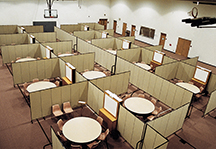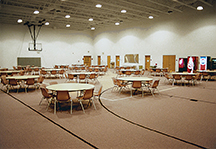
By Rich Maas
![]()
As your church finds itself in need of more ministry space, a new building might seem like a logical solution. But, in the interest of stewardship, it pays to consider whether or not an existing space can be reimagined instead.
Many churches have opted to divide the facilities they have to accommodate growth — but, how can you know that will be sufficient at your own church?
Start with the growth outlook

Knowing how to move forward is really a function of the amount of additional ministry space needed and the amount of space available to accommodate anticipated growth.
When massive growth of 40 percent or more is expected, nuts-and-bolts construction or facility renovation might indeed be in order. After all, you can’t have people stepping over each other. So, while the good news is that the ministry is growing, your church probably does need to get out the shovels.
On the other hand, projected growth of 10 percent to 30 percent can very often be accommodated with the efficient use of existing space.
Cost savings potential
Having spent considerable time in the church marketplace — and based on some general church construction marketplace statistics — our company can offer some ballpark figures for traditional construction or expansion projects based on scope and size:

Take, for example, Canaan Baptist Church in St. Louis, MO. This 20-classroom project — in a 7,800-square-foot space — was completed by our team about 10 years ago, predominantly with dividers from our Portable Classroom line. A project architect actually referred church leaders to our company. Most clients would simply require the necessary linear footage of acoustical portable dividers to create the 20 classrooms. This could be accomplished at the time for an investment of roughly only $30,000.

However, not only did this church need to create 20 Sunday school classroom areas, but it also needed some other furnishings common to a classroom — storage space for teaching material, a marker board and, of course, a work surface area for the teacher. These features made the necessary dividers more useful (but also a bit more expensive) than a more basic model.
Even so, the investment paled in comparison to the cost of traditional construction, which church leaders also considered.
In this case, the classrooms would only be used part-time; so nuts-and-bolts construction didn’t make the best financial sense. Instead, church leaders invested $50,000 in room dividers. So, they not only saved money but made more efficient use of their space, all while achieving their ministry objective of 20 classrooms.
Another financial consideration is future expansion. When the time does come for a new facility, these same dividers can be rolled over to the new building.

Surveying your space — does division make sense?
Over the years, our team has learned that certain facilities on a church campus are more “divisible” than others. Large, open spaces such as gymnasiums, as well as fellowship halls / family life centers, are usually excellent candidates. Churches often outgrow their original worship space — but, they certainly won’t knock them down. Instead, they’ll repurpose them.
Ceiling height is also important. Many gymnasiums have high or sloped ceilings; in these spaces, floor-to-ceiling room dividers simply won’t work. In spaces like these, portable room dividers represent a more

flexible, cost-effective solution.
Don’t get me wrong: Floor-to-ceiling room dividers can work wonderfully in spaces with 8- or 10-foot ceilings. Here, they create honest-to-goodness “walls.” Plus, the church also enjoys better sound absorbency.
The downside is that they’re very expensive and not very flexible. You can move them one way or another, but you can’t move them to be useful in another part of the church — or even three feet this way or that way — because they’re built into the building.
Ministry happens here
From small group classes, to Sunday school spaces, to nurseries and childcare areas, thoughtfully dividing an existing space is just good stewardship — good ministry and use of funds. Many of our thoughtful customers use the same portable dividers for Sunday school classrooms on Sunday; childcare during weekdays; and bible study and other programs in the evenings and on Saturdays.
Dividing up the space you have creates smaller, more intimate areas for private ceremonies, including baby showers, wedding showers, funerals, or even private areas for nursing mothers.
It’s also a good option for churches meeting in adaptive reuse settings — former retail stores or warehouses, for example. (And really, what other practical ways exist to easily subdivide these types of areas? Answer: none!)
Thoughtful division is truly “stewardship of space.”
Rich Maas is vice president at Screenflex Portable Room Dividers in Lake Zurich, IL.


